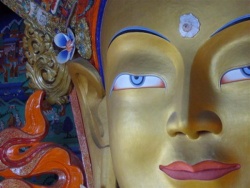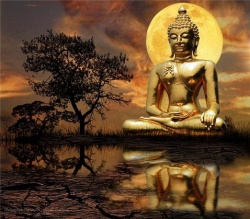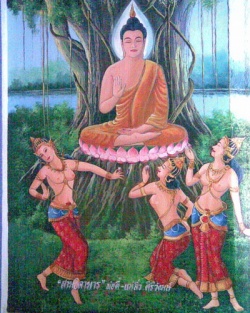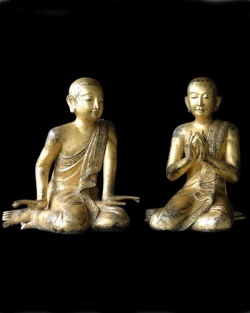Difference between revisions of "Kammatthanas"
m (Text replacement - "Category:Pali terminology" to "{{PaliTerminology}}") |
|||
| Line 1: | Line 1: | ||
[[File:G95-400x300.jpg|thumb|250px|]] | [[File:G95-400x300.jpg|thumb|250px|]] | ||
<poem> | <poem> | ||
| − | In [[Buddhism]], [[kammaṭṭhāna]] is a [[Pali]] word ([[Sanskrit]]: [[karmasthana]]) which literally means the place of work. Figuratively it means the place within the mind where one goes in order to work on [[spiritual]] development. More concretely, it refers to the forty canonical objects of meditation ([[samatha]] [[kammaṭṭhāna]]), listed in the third chapter of the [[Visuddhimagga]]. | + | In [[Buddhism]], [[kammaṭṭhāna]] is a [[Pali]] [[word]] ([[Sanskrit]]: [[karmasthana]]) which literally means the place of work. Figuratively it means the place within the [[mind]] where one goes in order to work on [[spiritual]] [[development]]. More concretely, it refers to the forty [[Wikipedia:canonical|canonical]] [[objects of meditation]] ([[samatha]] [[kammaṭṭhāna]]), listed in the third [[chapter]] of the [[Visuddhimagga]]. |
| − | Each [[kammatthana]] can be prescribed, especially by a teacher ([[kalyāṇa-mitta]]), to a certain individual student at some specific point, by assessing what would be best for that student's temperament and the present state of his or her [[mind]]. | + | Each [[kammatthana]] can be prescribed, especially by a [[teacher]] ([[kalyāṇa-mitta]]), to a certain {{Wiki|individual}} [[student]] at some specific point, by assessing what would be best for that student's {{Wiki|temperament}} and the {{Wiki|present}} [[state]] of his or her [[mind]]. |
| − | Forty [[meditation]] subjects | + | Forty [[meditation]] [[subjects]] |
| − | Of the forty objects meditated upon as [[kammatthana]], the first ten are 'things that one can behold directly', '[[kasina]]', or 'a whole': | + | Of the forty [[objects]] [[meditated]] upon as [[kammatthana]], the first ten are 'things that one can behold directly', '[[kasina]]', or 'a whole': |
| − | (1) earth, (2) water, (3) fire, (4) air, wind, (5) blue, green, (6) yellow, (7) red, (8) white, (9) enclosed space, (10) bright light. | + | (1) [[earth]], (2) [[water]], (3) [[fire]], (4) [[air]], [[wind]], (5) blue, green, (6) [[yellow]], (7) red, (8) white, (9) [[enclosed space]], (10) [[bright light]]. |
[[File:Gb.buddha.moon.jpg|thumb|250px|]] | [[File:Gb.buddha.moon.jpg|thumb|250px|]] | ||
| − | The next ten are objects of repulsion ([[asubha]]): | + | The next ten are [[objects of repulsion]] ([[asubha]]): |
(1) swollen corpse, (2) discolored, bluish, corpse, (3) festering corpse, (4) fissured corpse, (5) gnawed corpse, (6,7) dismembered, or hacked and scattered, corpse, (8) bleeding corpse, (9) worm-eaten corpse, (10) skeleton. | (1) swollen corpse, (2) discolored, bluish, corpse, (3) festering corpse, (4) fissured corpse, (5) gnawed corpse, (6,7) dismembered, or hacked and scattered, corpse, (8) bleeding corpse, (9) worm-eaten corpse, (10) skeleton. | ||
| − | Ten are recollections ([[anussati]]): | + | Ten are [[recollections]] ([[anussati]]): |
| − | First three recollections are of the virtues of the Three Jewels: | + | First three [[recollections]] are of the [[virtues]] of the [[Three Jewels]]: |
(1) [[Buddha]] | (1) [[Buddha]] | ||
| Line 23: | Line 23: | ||
(3) [[Sangha]] | (3) [[Sangha]] | ||
| − | Next three are recollections of the virtues of: | + | Next three are [[recollections]] of the [[virtues]] of: |
[[File:Ge008.jpg|thumb|250px|]] | [[File:Ge008.jpg|thumb|250px|]] | ||
| − | (4) morality ([[Śīla]]) | + | (4) [[morality]] ([[Śīla]]) |
(5) liberality ([[cāga]]) | (5) liberality ([[cāga]]) | ||
| − | (6) the wholesome attributes of [[Devas]] | + | (6) the [[wholesome]] [[attributes]] of [[Devas]] |
| − | Recollections of: | + | [[Recollections]] of: |
| − | (7) the body ([[kāya]]) | + | (7) the [[body]] ([[kāya]]) |
| − | (8) death (see [[Upajjhatthana Sutta]]) | + | (8) [[death]] (see [[Upajjhatthana Sutta]]) |
| − | (9) the breath ([[prāna]]) or breathing ([[ānāpāna]]) | + | (9) the [[breath]] ([[prāna]]) or [[breathing]] ([[ānāpāna]]) |
| − | (10) peace (see [[Nibbana]]). | + | (10) [[peace]] (see [[Nibbana]]). |
Four are stations of [[Brahma]] ([[Brahma-vihara]]): | Four are stations of [[Brahma]] ([[Brahma-vihara]]): | ||
[[File:Nikko.jpg|thumb|250px|]] | [[File:Nikko.jpg|thumb|250px|]] | ||
| − | (1) unconditional kindness ([[mettā]]) | + | (1) unconditional [[kindness]] ([[mettā]]) |
| − | (2) compassion ([[karuna]]) | + | (2) [[compassion]] ([[karuna]]) |
| − | (3) sympathetic joy over another's success ([[mudita]]) | + | (3) [[sympathetic joy]] over another's [[success]] ([[mudita]]) |
| − | (4) evenmindedness, equanimity ([[upekkha]]) | + | (4) evenmindedness, [[equanimity]] ([[upekkha]]) |
| − | Four are formless states (four [[arūpajhānas]]): | + | Four are [[formless states]] (four [[arūpajhānas]]): |
(1) [[infinite space]] | (1) [[infinite space]] | ||
| Line 50: | Line 50: | ||
(4) [[neither perception nor non-perception]]. | (4) [[neither perception nor non-perception]]. | ||
| − | One is of perception of disgust of food ([[aharepatikulasanna]]). | + | One is of [[perception]] of {{Wiki|disgust}} of [[food]] ([[aharepatikulasanna]]). |
| − | The last is analysis of the four elements ([[catudhatuvavatthana]]): earth ([[pathavi]]), water ([[apo]]), fire ([[tejo]]), air ([[vayo]]). | + | The last is analysis of the [[four elements]] ([[catudhatuvavatthana]]): [[earth]] ([[pathavi]]), [[water]] ([[apo]]), [[fire]] ([[tejo]]), [[air]] ([[vayo]]). |
| − | [[Meditation]] subjects and [[jhanas]] | + | [[Meditation]] [[subjects]] and [[jhanas]] |
[[File:Disciples of buddha.jpg|thumb|250px|]] | [[File:Disciples of buddha.jpg|thumb|250px|]] | ||
| − | Of these, due to their complexity, eight recollections (excluding the recollection of the Body ([[kāyagatāsati]]) and of Breathing ([[ānāpānassati]])), the [[perception]] of disgust of food and the analysis of the four elements only lead to access concentration ([[upacara samadhi]]). | + | Of these, due to their complexity, eight [[recollections]] (excluding the [[recollection]] of the [[Body]] ([[kāyagatāsati]]) and of [[Breathing]] ([[ānāpānassati]])), the [[perception]] of {{Wiki|disgust}} of [[food]] and the analysis of the [[four elements]] only lead to [[access concentration]] ([[upacara samadhi]]). |
| − | Absorption in the first [[jhana]] can be realized by [[mindfulness]] on the ten kinds of foulness and [[mindfulness]] of the [[body]]. However, these [[meditations]] cannot go beyond the [[first jhana]] due to their involving applied thought ([[vitaka]]) which is absent from the higher [[jhanas]]. | + | [[Absorption]] in the first [[jhana]] can be [[realized]] by [[mindfulness]] on the ten kinds of [[foulness]] and [[mindfulness]] of the [[body]]. However, these [[meditations]] cannot go beyond the [[first jhana]] due to their involving [[applied thought]] ([[vitaka]]) which is absent from the higher [[jhanas]]. |
| − | Absorption in the first three [[jhanas]] can be realized by contemplating the first three [[brahma-viharas]]. However, these [[meditations]] cannot aid in attaining the [[fourth jhana]] due to the pleasant [[feelings]] associated with them. Conversely, once the [[fourth jhana]] is induced, the fourth [[brahma-vihara]] ([[equanimity]]) arises. | + | [[Absorption]] in the first three [[jhanas]] can be [[realized]] by contemplating the first three [[brahma-viharas]]. However, these [[meditations]] cannot aid in [[attaining]] the [[fourth jhana]] due to the [[pleasant]] [[feelings]] associated with them. Conversely, once the [[fourth jhana]] is induced, the fourth [[brahma-vihara]] ([[equanimity]]) arises. |
[[File:Dd2655-grande.jpg|thumb|250px|]] | [[File:Dd2655-grande.jpg|thumb|250px|]] | ||
| − | Due to the simplicity of subject matter, all four [[jhanas]] can be induced through [[mindfulness]] of breathing and the ten [[kasinas]]. | + | Due to the [[simplicity]] of [[subject]] {{Wiki|matter}}, all four [[jhanas]] can be induced through [[mindfulness]] of [[breathing]] and the ten [[kasinas]]. |
| − | [[Meditation]] subjects and temperaments | + | [[Meditation]] [[subjects]] and temperaments |
| − | All of the aforementioned [[meditation]] subjects can suppress the [[Five Hindrances]], thus allowing one to fruitfully pursue [[wisdom]]. In addition, anyone can productively apply specific [[meditation]] subjects as antidotes, such as [[meditating]] on foulness to counteract lust or on the breath to abandon discursive [[thought]]. | + | All of the aforementioned [[meditation]] [[subjects]] can suppress the [[Five Hindrances]], thus allowing one to fruitfully pursue [[wisdom]]. In addition, anyone can productively apply specific [[meditation]] [[subjects]] as [[antidotes]], such as [[meditating]] on [[foulness]] to counteract [[lust]] or on the [[breath]] to abandon discursive [[thought]]. |
| − | The [[Pali]] commentaries further provide guidelines for suggesting [[meditation]] subjects based on ones general temperament: | + | The [[Pali]] commentaries further provide guidelines for suggesting [[meditation]] [[subjects]] based on ones general {{Wiki|temperament}}: |
| − | [[Greedy]]: the ten foulness [[meditations]]; or, [[body]] contemplation. | + | [[Greedy]]: the ten [[foulness]] [[meditations]]; or, [[body]] contemplation. |
| − | Hatred: the four [[brahma-viharas]]; or, the four color [[kasinas]]. | + | [[Hatred]]: the four [[brahma-viharas]]; or, the four {{Wiki|color}} [[kasinas]]. |
| − | Deluded: mindfulness of breath. | + | Deluded: [[mindfulness]] of [[breath]]. |
| − | Faithful: the first six recollections. | + | Faithful: the first [[six recollections]]. |
| − | Intelligent: recollection of death or peace; the [[perception]] of disgust of food; or, the analysis of the four elements. | + | {{Wiki|Intelligent}}: [[recollection of death]] or [[peace]]; the [[perception]] of {{Wiki|disgust}} of [[food]]; or, the analysis of the [[four elements]]. |
| − | Speculative: mindfulness of breath. | + | Speculative: [[mindfulness]] of [[breath]]. |
| − | The six non-color kasinas and the four formless states are suitable for all temperaments. | + | The six non-color [[kasinas]] and the four [[formless states]] are suitable for all temperaments. |
</poem> | </poem> | ||
{{W}} | {{W}} | ||
[[Category:Meditation]] | [[Category:Meditation]] | ||
{{PaliTerminology}} | {{PaliTerminology}} | ||
Latest revision as of 06:50, 3 October 2015
In Buddhism, kammaṭṭhāna is a Pali word (Sanskrit: karmasthana) which literally means the place of work. Figuratively it means the place within the mind where one goes in order to work on spiritual development. More concretely, it refers to the forty canonical objects of meditation (samatha kammaṭṭhāna), listed in the third chapter of the Visuddhimagga.
Each kammatthana can be prescribed, especially by a teacher (kalyāṇa-mitta), to a certain individual student at some specific point, by assessing what would be best for that student's temperament and the present state of his or her mind.
Forty meditation subjects
Of the forty objects meditated upon as kammatthana, the first ten are 'things that one can behold directly', 'kasina', or 'a whole':
(1) earth, (2) water, (3) fire, (4) air, wind, (5) blue, green, (6) yellow, (7) red, (8) white, (9) enclosed space, (10) bright light.
The next ten are objects of repulsion (asubha):
(1) swollen corpse, (2) discolored, bluish, corpse, (3) festering corpse, (4) fissured corpse, (5) gnawed corpse, (6,7) dismembered, or hacked and scattered, corpse, (8) bleeding corpse, (9) worm-eaten corpse, (10) skeleton.
Ten are recollections (anussati):
First three recollections are of the virtues of the Three Jewels:
(1) Buddha
(2) Dharma
(3) Sangha
Next three are recollections of the virtues of:
(4) morality (Śīla)
(5) liberality (cāga)
(6) the wholesome attributes of Devas
Recollections of:
(7) the body (kāya)
(8) death (see Upajjhatthana Sutta)
(9) the breath (prāna) or breathing (ānāpāna)
(10) peace (see Nibbana).
Four are stations of Brahma (Brahma-vihara):
(1) unconditional kindness (mettā)
(2) compassion (karuna)
(3) sympathetic joy over another's success (mudita)
(4) evenmindedness, equanimity (upekkha)
Four are formless states (four arūpajhānas):
(1) infinite space
(2) infinite consciousness
(3) infinite nothingness
(4) neither perception nor non-perception.
One is of perception of disgust of food (aharepatikulasanna).
The last is analysis of the four elements (catudhatuvavatthana): earth (pathavi), water (apo), fire (tejo), air (vayo).
Meditation subjects and jhanas
Of these, due to their complexity, eight recollections (excluding the recollection of the Body (kāyagatāsati) and of Breathing (ānāpānassati)), the perception of disgust of food and the analysis of the four elements only lead to access concentration (upacara samadhi).
Absorption in the first jhana can be realized by mindfulness on the ten kinds of foulness and mindfulness of the body. However, these meditations cannot go beyond the first jhana due to their involving applied thought (vitaka) which is absent from the higher jhanas.
Absorption in the first three jhanas can be realized by contemplating the first three brahma-viharas. However, these meditations cannot aid in attaining the fourth jhana due to the pleasant feelings associated with them. Conversely, once the fourth jhana is induced, the fourth brahma-vihara (equanimity) arises.
Due to the simplicity of subject matter, all four jhanas can be induced through mindfulness of breathing and the ten kasinas.
Meditation subjects and temperaments
All of the aforementioned meditation subjects can suppress the Five Hindrances, thus allowing one to fruitfully pursue wisdom. In addition, anyone can productively apply specific meditation subjects as antidotes, such as meditating on foulness to counteract lust or on the breath to abandon discursive thought.
The Pali commentaries further provide guidelines for suggesting meditation subjects based on ones general temperament:
Greedy: the ten foulness meditations; or, body contemplation.
Hatred: the four brahma-viharas; or, the four color kasinas.
Deluded: mindfulness of breath.
Faithful: the first six recollections.
Intelligent: recollection of death or peace; the perception of disgust of food; or, the analysis of the four elements.
Speculative: mindfulness of breath.
The six non-color kasinas and the four formless states are suitable for all temperaments.





